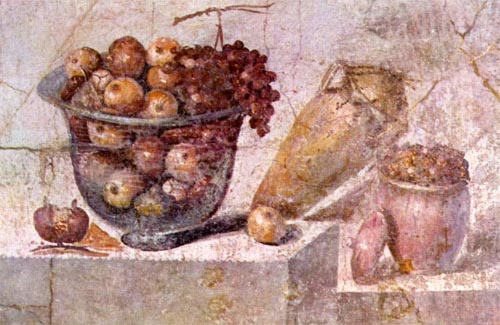Like the Greeks, the Romans had three meals a day. At breakfast, they ate bread, cheese, fruit, milk or wine. At noon, cold fish, cheese, fruit, and wine were served for lunch. The main and the richest meal was dinner: large portions of hot dishes were served then. The Romans’ lunch consisted of three courses. At first, snacks were served and, first of all, eggs. This is the origin of the Roman proverb „from eggs to apples” (ab ovo usque ad mala), an ancient version of the contemporary „from A to Z „ since apples and other fruits were served at the end of the meal.

The favorite drink was „ mulsum” – wine mixed with honey.
From one epoch to another and depending on family wealth, the preferences for different wines were changing. Horace celebrated the best Italian wines: the wine of Falern – from the vineyards of Falern in Campania, Massician – from the region of the Latium periphery and Campania, Caecubian – from the region where Latium bordered the Tyrrhenian Sea. However, in the amphorae found in Pompeii other types of wines produced in Italy e.g. Capua wine were identified.
Wine was an important component of the daily meals, for which reason it was not refused even to slaves. Of course, they consumed low quality wine produced from wine marc. Moreover, daily quotas were established for slaves. A detailed account of how much wine the master had to give to his slaves is described in Cato the Elder’s treaty.
Considering that the wine produced in its own vineyards was relatively cheap at the time, Cato manifested great generosity towards his servants. Thus, Cato believed that every slave should receive from 2.5 congii (about 8.2 L) to an amphora (26.25 L) per month. On Saturnalia and Compitalia, slaves received 3,5 congii i.e. about 11.5 L. The total quantity for each slave, calculated by Cato, was more than 7 quadrantals (180 L) of wine (Cato’s Agriculture, LVII).
Those familiar with winemaking used different methods to change the taste and strength of different types of wine. Moreover, gourmands were not indifferent to what food was served with each wine:
If Massician wine is left out, under the open sky,
Cold air will clean up the last slurry
Removing the unpleasant and harmful smell
But if it is passed through the cloth, it will lose all its taste.
If Surrentian wine is added to Falernian,
You must add a dove egg as soon as possible,
The yolk will take all the slurry to the bottom.
To incite the tired guest to drink,
Serve fried crayfish, offer African snails,
But do not give him salads, for it is useless for wine
Floats above; but best – pastry and salami.
Horace, Satires II, 4
The Romans paid particular attention to the vessels used in the production of wine: for mixing, heating or cooling.

There have also been times when laws have been enacted that forbid women to drink wine. Quoting the ancient authors, Aulus Gellius (Attic Nights, X, 23) notes that neither in Rome nor elsewhere in Latium women are allowed to drink strong wines and to show respect for the law, they kissed their relatives, to convince them that they do not smell of alcohol. The Romans allowed their sisters and daughters to drink weak wine, made from grape marc or raisins. Cato the Eldert says that during the Republic, drinking women not only had a bad reputation, but were punished like those who cheated on their husbands.
Lidia Winniczuk. Ludzie, zwyczaje, obyczaje starozytnej Grecji i Rzymu, Panstwowe wydawanictwo naukowe, Warszawa, 1983.
5 comments
Rikki
Lidl introduce plenty of new world wines to their range, launching in stores on 24 January 2019… Lidl’s latest Wine Tour focusses on the new world and includes, among others, a New Zealand Sauvignon, a Chilean Cabernet and an Aussie Shiraz.
Charles
Northern Italian pinot noir aka pinot nero have similar earthy notes as in France, but they get a bit riper. These wines are darker, rich and earthy. These Italian pinot noir are a good value around $20 but range to upwards of $70. Perfect for a sunny spring day.
Kevin
Use Review Centre to compare red wines
Desmond
With softer tannins than its Bordeaux partner Cabernet Sauvignon, Merlot is an easy-drinking variety that is widely grown in South Africa. The wine has strong red fruit notes – think cherries, plums, red berries and even fruitcake. Certain Merlots will have an herbal aroma, and still others are fuller, with flavours of coffee and chocolate.
Elizabeth
And here I agree with you